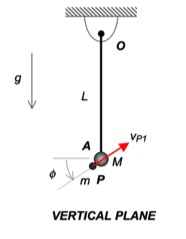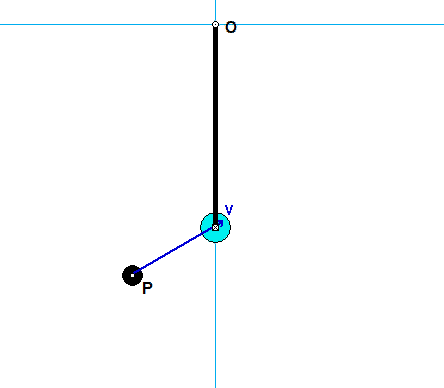| Problem statement Solution video |
DISCUSSION THREAD

Any questions?? Please ask/answer questions regarding this homework problem through the "Leave a Comment" link above.
Discussion

You are asked to investigate the dynamics of this system during the short time of impact of P with A.
- It is suggested that you consider a system made up of A+P+bar (make the system "big").
- Draw a free body diagram (FBD) of this system.
- For this system, linear momentum is NOT conserved since there are non-zero reaction forces at O.
- Furthermore, energy is NOT conserved since there is an impact of P with A during that time.
- From your FBD of the system, you see that the moment about the fixed point O is zero. What does this say about the angular momentum of the system about O during impact? (Answer: It is conserved!)
HINTS:
STEP 1 - FBD: Draw a SINGLE free body diagram (FBD) of the system of A+P+bar.
STEP 2 - Kinetics: Consider the discussion above in regard to conservation of angular momentum about point O. Recall how to calculate the angular momentum about a point for a particle.
STEP 3 - Kinematics: At Instant 2, the P sticks to A: vP2 = vA2.
STEP 4 - Solve.
A good example of a problem like this is Example 4.D.5
Remember that velocity two can be substituted with an expression with angular velocity in it. When setting both Ho1 and Ho2 equal to each other, that should help solve for the angular velocity.
Is this problem an example of when it would be appropriate to omit the gravitational effects during the solution process? As I recall from lecture, we are able to omit the effects of gravity during collisions, as the collision forces are much larger.
Your recollection is correct. The impact force is "impulsive": large amplitude force acting over a very short time. The impulse of such a force (its integral over time) is finite, giving a finite change in speed during the impact. The gravitational force is not impulsive. Instead, the impulse of the gravitational force is very small since it is the integral of that force over a very short time, and, consequently, has little influence on the change of momentum.
In short, you can neglect non-impulsive forces such as weight, spring and friction forces.
Good question.
For this question, it is important to take note of your conservation of angular momentum equation. Since the angular momentum is conserved, H1=H2, and this can be simplified pretty easy since the velocity of P equals that of the velocity of A. As said above, if you have any trouble with this problem, I highly recommend looking at example 4.D.5, which is almost identical to this one.
I agree, the relationship between angular velocity and velocity is also crucial to solving this problem. Having both the angular velocity and radius, the velocity can easily be found.
Well said, William!
Do note that if you use example 4.D.5 for reference, one thing you need to keep in mind is that the angle and how you break down to its i and j components for velocity when calculating the angular momentum.
Making your FBD the entire system, angular momentum is conserved